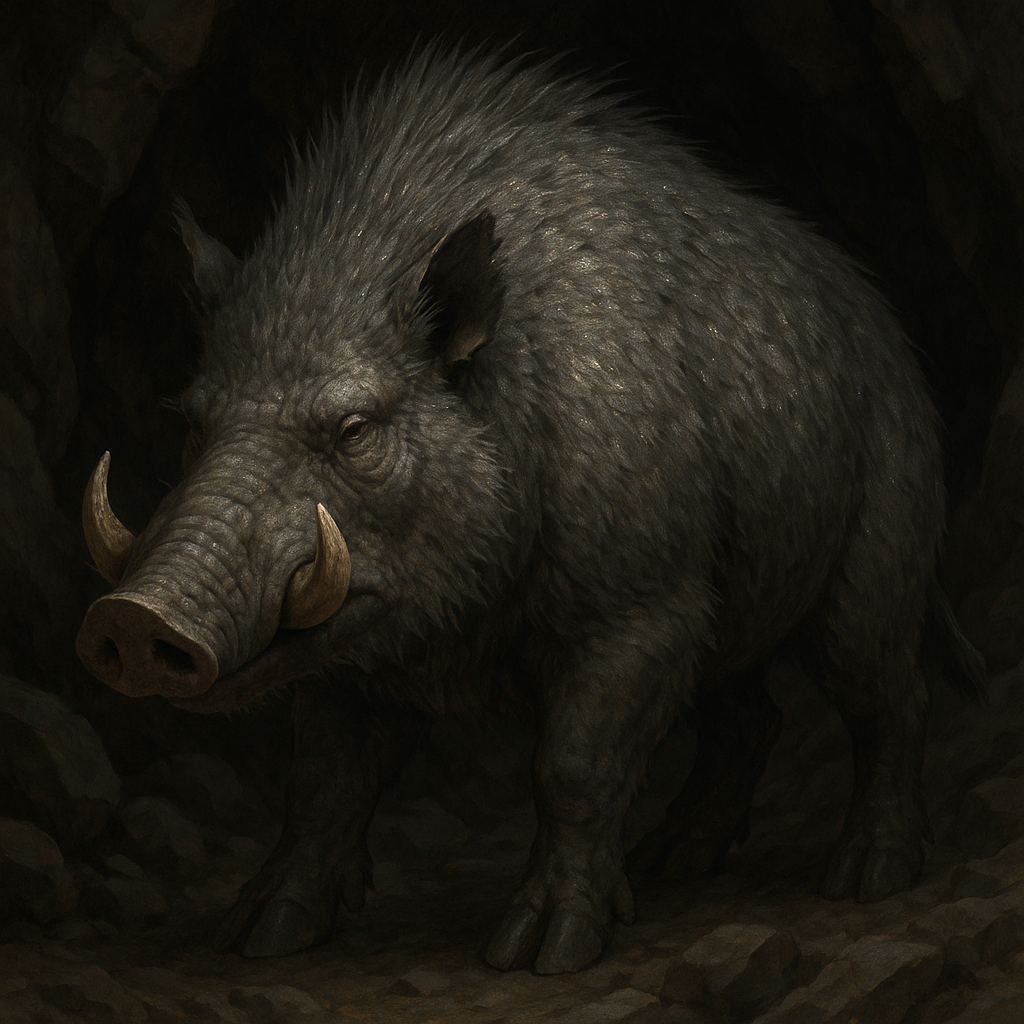Cave-Hog
Dwarven Name: Groth'harn (lit. “Stone-Bristle”)
Classification: Mammalian Herbivore
Origin: Deep Warrens of Vashkelholme
Domestication Status: Semi-Domesticated
The Cave-hog, or Groth'harn, is a bulky, tusked mammal native to the deep subterranean expanses beneath the Dwarven kingdom of Vashkelholme. Covered in coarse, gray bristles speckled with flecks of metallic sheen, Cave-hogs are adapted to life underground, with poor eyesight, an exceptional sense of smell, and thick hooves built for scaling rocky terrain. Their snouts are broad and shovel-like, perfect for rooting through mineral-rich fungus fields and stone-lichen.
Cultural Significance
- Stonebread Folk Tale: A popular Dwarven fable claims the first Stonebread was baked using a Cave-hog’s back as a griddle after a mining collapse.
- Honor Offerings: Young Dwarves seeking to prove themselves often raise a Cave-hog from piglet to plow-beast, then present it at feasts.
- Combat Pigs: In wartime, specially bred and armored War-Hogs are used to break enemy lines, their tusks sharpened to brutal effect.
Basic Information
Anatomy
Biology
- Average Length: 1.5–2.2 meters
- Height at Shoulder: 1.1 meters
- Weight: 300–500 kg
- Lifespan: 18–24 years
- Coloration: Slate grey, charcoal, mossy green, with bronze or copper bristle flecks
Cave-hogs have a two-chambered stomach that allows for fermentation of otherwise inedible flora. Their waste is unusually nutrient-rich and is used by Dwarves in subterranean farming.
Distinctive features:
- Bioluminescent tusk rings, formed from the consumption of Glowshroom spores.
- A deep baritone grunt that echoes for miles underground.
- An inbuilt digestive filter that allows them to process lichen, stonebark, and certain low-grade ores.
Ecology and Habitats
Cave-hogs are commonly found in:
- Fungal caverns (particularly Glowgroves)
- Heated volcanic tunnels
- Man-dug root pastures within Dwarven holds
They are not suited for surface life and react poorly to open skies and sunlight.
Dietary Needs and Habits
Fungivorous/Detritivorous (fungi, root-veggies, mineral moss, carrion in dire times)
Behaviour
They are notoriously food-driven, and offering a mushroom loaf or fruit chunk can win their affection quickly.
Hazards
- Aggression: During rutting season, males become territorial.
- Overfeeding: Leads to dangerous flatulence, which in enclosed tunnels is considered both a health and fire hazard.
- Tusks: Sharp, and they charge when startled.
"Better to face a Troll than stand between a sow and her slop."
Additional Information
Social Structure
Cave-hogs are social, often herding in groups of 6–12. They communicate via snorts, tail flicks, and low rumbles. They can bond with handlers over time, often choosing one "bondkin" to follow stubbornly through hell and high shale.
Domestication
Training Difficulty: Moderate. Intelligent enough to follow basic commands, but stubborn and prone to “rooting tantrums” if underfed or bored.
Uses, Products & Exploitation
Cave-hogs are highly valued by Dwarves for their:
- Meat: Rich, earthy, and fatty; often salted or smoked.
- Milk: Thick, pungent, and often fermented into Hog-cheese.
- Hide: Durable and naturally fungus-resistant; used for boots and belts.
- Tusks: Used in ceremonial crafting and as tool material.
- Muck: A prized fertilizer in Dwarven shroomfields.
| Byproduct | Use |
|---|---|
| Hogfat | Cooking, lamp oil base |
| Cave-Hog Hide | Armor, Books, Belts |
| Tusk Shavings | Fertilizer, alchemy bases |
| Milk | Drinking, cheese-making |
| Droppings | Fungal farm compost |
Symbiotic and Parasitic organisms
A notable example of mutualism, Blood-Bats roost in the bristles and natural folds of Cave-hogs’ backs. They clean pests and feed on blood-engorged mites, while providing sensitive echolocation cues—often forming warning chirps when danger draws near. Dwarven scouts have learned to “read” these chirps and often refer to bonded hog-bat duos as "Echo-Partners."




Comments